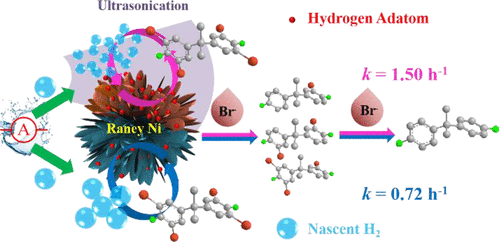当前位置:
X-MOL 学术
›
ACS ES&T Eng.
›
论文详情
Our official English website, www.x-mol.net, welcomes your
feedback! (Note: you will need to create a separate account there.)
Ultrasonication-Enhanced Reduction of Tetrabromobisphenol A by Activating Nascent H2 on Raney Ni Catalyst: Kinetics, Mechanisms, and Hydrogenation Pathways
ACS ES&T Engineering ( IF 7.4 ) Pub Date : 2021-04-07 , DOI: 10.1021/acsestengg.1c00044 Weilai Wang 1 , Kaixuan Wang 1 , Dahong Huang 2 , Chengzhi Zhou 2 , Wen Zhang 3 , Junfeng Niu 1, 2
ACS ES&T Engineering ( IF 7.4 ) Pub Date : 2021-04-07 , DOI: 10.1021/acsestengg.1c00044 Weilai Wang 1 , Kaixuan Wang 1 , Dahong Huang 2 , Chengzhi Zhou 2 , Wen Zhang 3 , Junfeng Niu 1, 2
Affiliation

|
The deep dehalogenation of polyhalogenated organic pollutants is receiving widespread attention. In this work, Raney Ni (R-Ni) catalyst with a sponge porous structure was selected, and nascent hydrogen (Nas-H2) bubbles generated in situ from the cathode were used as a hydrogen source for tetrabromobisphenol A (TBBPA) hydrodebromination. The reaction conditions were first optimized by adjusting R-Ni dosage and Nas-H2 production. On this basis, the investigation showed that the hydrogen utilization in the R-Ni/Nas-H2 system was hundreds of times higher than that in the control group injected with regular hydrogen gas due to the refinement of hydrogen bubble size. Furthermore, the ultrasonication-enhanced R-Ni/Nas-H2 system was constructed. The experimental results showed that the hot spots and microjets generated by cavitation promoted the dispersion of the R-Ni catalyst, the nanonization of Nas-H2 bubbles, and the mass transfer. TBBPA degradation and the debromination ratio reached 94.6% and 68.2% in 2.0 h, respectively, in which the hydrogen adatoms (Hads*) produced by the dissociative adsorption of hydrogen molecules are the active species. TBBPA debromination follows pseudo-first-order kinetics with a rate constant of 1.50 h–1, which is 2.1 times higher than that without ultrasonication. In addition, TBBPA follows the gradual hydrodebromination, and the toxicity of the hydrogenated product decreases with the reduction of bromine atoms. The coupled ultrasonication and R-Ni/Nas-H2 system may hold great potential for the efficient removal of TBBPA from contaminated water.
中文翻译:

通过活化阮内镍催化剂上的新生H2超声增强四溴双酚A的还原:动力学,机理和加氢途径。
多卤代有机污染物的深度脱卤正受到广泛关注。在这项工作中,选择了具有海绵多孔结构的阮内镍(R-Ni)催化剂,将从阴极原位产生的新生氢(Nas-H 2)气泡用作四溴双酚A(TBBPA)加氢脱溴的氢源。首先通过调节R-Ni剂量和Nas-H 2产量来优化反应条件。在此基础上,研究表明,由于氢气泡尺寸的细化,R-Ni / Nas-H 2系统中的氢气利用率比注射常规氢气的对照组高数百倍。此外,超声增强的R-Ni / Nas-H 2系统已构建。实验结果表明,空化产生的热点和微射流促进了R-Ni催化剂的分散,Nas-H 2气泡的纳米化和传质。在2.0 h内,TBBPA的降解和脱溴率分别达到了94.6%和68.2%,其中由氢分子的解吸附产生的氢原子(H ads *)是活性物质。TBBPA脱溴遵循假一阶动力学,速率常数为1.50 h –1,这是不使用超声波的情况下的2.1倍。另外,TBBPA遵循逐步加氢脱溴作用,氢化产物的毒性随着溴原子的减少而降低。超声和R-Ni / Nas-H 2耦合系统可能具有从污染水中有效去除TBBPA的巨大潜力。
更新日期:2021-05-14
中文翻译:

通过活化阮内镍催化剂上的新生H2超声增强四溴双酚A的还原:动力学,机理和加氢途径。
多卤代有机污染物的深度脱卤正受到广泛关注。在这项工作中,选择了具有海绵多孔结构的阮内镍(R-Ni)催化剂,将从阴极原位产生的新生氢(Nas-H 2)气泡用作四溴双酚A(TBBPA)加氢脱溴的氢源。首先通过调节R-Ni剂量和Nas-H 2产量来优化反应条件。在此基础上,研究表明,由于氢气泡尺寸的细化,R-Ni / Nas-H 2系统中的氢气利用率比注射常规氢气的对照组高数百倍。此外,超声增强的R-Ni / Nas-H 2系统已构建。实验结果表明,空化产生的热点和微射流促进了R-Ni催化剂的分散,Nas-H 2气泡的纳米化和传质。在2.0 h内,TBBPA的降解和脱溴率分别达到了94.6%和68.2%,其中由氢分子的解吸附产生的氢原子(H ads *)是活性物质。TBBPA脱溴遵循假一阶动力学,速率常数为1.50 h –1,这是不使用超声波的情况下的2.1倍。另外,TBBPA遵循逐步加氢脱溴作用,氢化产物的毒性随着溴原子的减少而降低。超声和R-Ni / Nas-H 2耦合系统可能具有从污染水中有效去除TBBPA的巨大潜力。











































 京公网安备 11010802027423号
京公网安备 11010802027423号